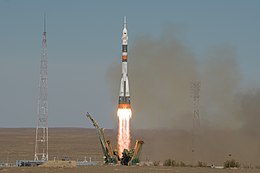
Back سايوز إم إس-10 Arabic Союз МС-10 Bulgarian Sojuz MS-10 Czech Sojus MS-10 German Soyuz MS-10 Spanish سایوز اماس-۱۰ Persian Sojuz MS-10 Finnish Soyouz MS-10 French Soiuz MS-10 Galician סויוז MS-10 HE
 Launch of the Soyuz-FG rocket carrying the MS-10 spacecraft | |
| Mission type | ISS crew transport (planned) |
|---|---|
| Operator | Roscosmos |
| Mission duration | 19 minutes, 41 seconds (achieved) 180 days (planned) |
| Orbits completed | Failed to orbit |
| Apogee | 93 km (58 mi) sub-orbital spaceflight |
| Spacecraft properties | |
| Spacecraft | Soyuz MS No. 740 |
| Spacecraft type | Soyuz MS (11F747) |
| Manufacturer | Energia |
| Crew | |
| Members | |
| Callsign | Burlak |
| Start of mission | |
| Launch date | 11 October 2018, 08:40 UTC |
| Rocket | Soyuz-FG (U15000-064) |
| Launch site | Baikonur, Pad 1/5 |
| Contractor | RKTs Progress |
| End of mission | |
| Landing date | 11 October 2018, 08:59 UTC |
| Landing site | 20 km (12 mi) east of Jezkazgan, Kazakhstan |
 Mission patch  Hague and Ovchinin | |
Soyuz MS-10 was a crewed Soyuz MS spaceflight that aborted shortly after launch on 11 October 2018[1][2] due to a failure of the Soyuz-FG launch vehicle boosters.[3][4] MS-10 was the 139th flight of a Soyuz spacecraft. It was intended to transport two members of the Expedition 57 crew to the International Space Station. A few minutes after liftoff, the craft went into contingency abort due to a booster failure and had to return to Earth. By the time the contingency abort was declared, the launch escape system (LES) tower had already been ejected and the capsule was pulled away from the rocket using the solid rocket jettison motors on the capsule fairing.[5] Both crew members, Roscosmos cosmonaut Aleksey Ovchinin and NASA astronaut Nick Hague, were recovered in good health.[3] The MS-10 flight abort was the first instance of a Russian crewed booster accident in 35 years, since Soyuz T-10-1 exploded on the launch pad in September 1983.[6][7][8] On 1 November 2018, Russian scientists released a video recording of the mission.[9]
- ^ NASA (17 September 2018). "Expedition 57". Retrieved 20 September 2018.
- ^ Pietrobon, Steven (5 February 2017). "Russian Launch Manifest". Retrieved 12 February 2017.
- ^ a b Garcia, Mark (11 October 2018). "Crew in Good Condition After Booster Failure". NASA Space Station. Retrieved 11 October 2018.
- ^ Harwood, William (11 October 2018). "Soyuz crew lands safely after emergency launch abort". Spaceflight Now. Retrieved 12 October 2018.
- ^ Cite error: The named reference
zak_MS-10was invoked but never defined (see the help page). - ^ Sanchez, Merri J. (March 2000). "A Human Factors Evaluation of a Methodology for Pressurized Crew Module Acceptability for Zero-Gravity Ingress of Spacecraft" (PDF). Houston, Texas: Lyndon B. Johnson Space Center. p. 8. Archived from the original (PDF) on 5 October 2006. Retrieved 20 October 2007.
- ^ Zak, Anatoly. "History of Soyuz Escape System". RussianSpaceWeb.com. Retrieved 12 October 2018.
- ^ Evans, Ben (28 September 2013). "'We Were Swearing!' Thirty Years Since Russia's Brush With Disaster". AmericaSpace.
- ^ Berger, Eric (1 November 2018). "Dramatic footage of Soyuz accident shows rocket booster collision – For the second human launch in a row, there's a likely quality control issue". Ars Technica. Retrieved 1 November 2018.